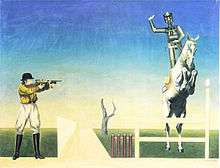Harue Koga


Harue Koga (古賀 春江 Koga Harue, June 18, 1895 - September 10, 1933) was a Japanese surrealist/avant-garde[1] painter active in the Taishō period and early Showa Period.
His life
His birth name was Yoshio Koga (古賀 亀雄). He was born in Kurume on the island of Kyushu in western Japan. His father was the head priest of the Buddhist Zenpuku Temple in the city. He enjoyed painting when he was he child and in 1912 he dropped out of school and moved to Tokyo to study art. He studied at the Pacific Ocean Art Institute and the Japanese Watercolor Painting Institute. He returned to his hometown after the suicide of his housemate in 1915. The following year he entered the Buddhist priesthood and returned to Tokyo. On entering the priesthood he was renamed Harue. In order to follow in his father's footstep, he entered university to study theology in 1916. He dropped out in 1918 though, and from this point on would concentrate on painting. After a slump lasting several years, he won Nika Prize for Burial (also known as Entombment) and From the Upstairs Window in 1922. He became one of the 13 founder members of an avant-garde art group "Action" in the same year. He was heavily influenced by Paul Klee between 1926 and 1929 and painted a series of magical childlike works.[2] In 1929 he became good friends with Yasunari Kawabata.[1] A lot of his art works were influenced by the movements and painters in the West such as cubism (Fernand Léger), surrealism, Klee, etc., and his style changed one after another in a short term.

_by_Harue_Koga.jpg)
Sea, Koga's most famous work first appeared at the 16th Nika Exhibition in 1929. It contains various motifs which Koga had copied from magazines and post cards. Koga continued to paint in this photomontage-style with the Asahi Graph becoming the most common source of motifs.[2] Other notable Koga photomontage-style works are Makeup Out-of-Doors and Intellectual Expression Traversing a Real Line. In 1929 the work Innocent Moonlit Night was also first exhibited. This colorful work displays the influence of Giorgio de Chirico, an influence that would reappear intermittently in Koga's works over the next year years.[2] The years following Sea are generally considered to be the beginning of surrealism painting in Japan.